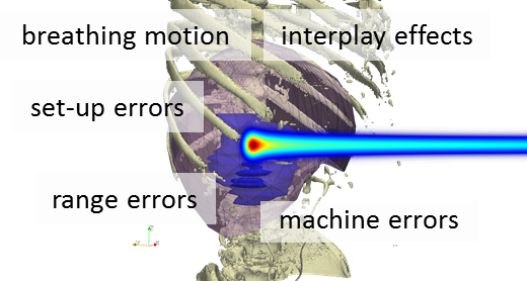4D Plan Evaluation
Evaluating the combined effect of several uncertainties on plans for indications in the thorax affected by motion
Treating moving targets located in the thorax with scanned proton treatments can lead to pronounced differences between planned and delivered tumor dose. These differences may be a result of treatment machine uncertainties, setup and range errors, and the interplay effect. The latter occurs due to the relative motion between the target and proton beam delivery.
The aim of this project is to develop and validate a tool that realistically evaluates all these delivery effects, prior to the start of a patient's treatment. In clinical practice, this comprehensive 4D treatment plan evaluation tool will help to assess the need for (further) motion mitigation techniques for this group of patients.
People involved
Cássia Oraboni Ribeiro, Sabine Visser, Erik Korevaar, Arturs Meijers, Marianna Sijtsema, Melissa Anakotta, Margriet Dieters, Robin Wijsman, Kristel Muijs, Antje Knopf, Hans Langendijk, Stefan Both
Collaborators
Ion Beam Applications (IBA), Advanced Technology Group, Louvain-la-Neuve, Belgium:
Guillaume Janssens
OncoRay, Dresden, Germany:
Annika Jakobi, Kristin Stützer, Christian Richter
References
T. Inoue et al. “Limited Impact of Setup and Range Uncertainties, Breathing Motion, and Interplay Effects in Robustly Optimized Intensity Modulated Proton Therapy for Stage III Non-small Cell Lung Cancer”, Int. J. Radiat. Oncol. 96 661–9 2016 (pdf)
C. O. Ribeiro et al. “Comprehensive 4D robustness evaluation for pencil beam scanned proton plans”. Radiother. Oncol. 2019; 136: 185-189.

 English
English
 Nederlands
Nederlands
